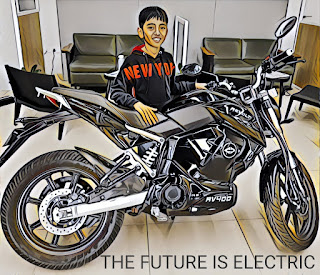The r-EV-olution in India
It’s been two years now that I have been using an EV (an
electric bike, rather the first e-bike of India) and a lot has changed in the
last two years in the electric mobility space which can be called a revolution.
From the last couple of years, COVID 19 had adversely impacted the penetration
of EVs in India and so the rEVoution which was supposed to take place by
mid-2021 is visible now. The automotive industry is going through a transition
switching to alternative and less energy-intensive options of mobility due to
two reasons: first the rising fuel prices and then the environmental concern. I
haven’t seen such excitement for electric vehicles as I am seeing right now. At
the start of 2020, there were hardly any EVs on the Pune roads, whereas in
2022, I could see at least a dozen vehicles with green number plates plying on
the same roads in Pune. However, there’s still a long way to go. EV demand got
a fillip of late as fuel prices soared, making many buyers of conventional
vehicles consider other options. Increasing oil import bills as well as
international commitments to combat global climate change are among key factors
driving the Indian government’s recent policy initiatives to speed up the
transition to e-mobility.
Of every 100 two-wheeler buyers in India, just one buys an
electric vehicle (EV). But the buzz in the marketplace could have you believe
that things are moving much faster on the ground than they actually are. The
electric vehicle market in India is still in its nascent stages at present, but
it is poised to emerge as one of the leading electric vehicle markets in the
world. India's electric vehicle market size is expected to reach USD 152.21
billion by 2030 and is expected to expand at a CAGR of 94.4% from 2021 to 2030.
The stringent regulations being drafted by the Indian government in response to
the rising levels of vehicular emissions and the growing demand for
environment-friendly vehicles are expected to drive the growth of the market
over the forecast period. The Indian government has been pursuing consistent
and committed efforts and has already drafted dedicated EV policies and rolled
out various demand and supply incentives as part of the efforts to encourage
the adoption of e-mobility across various market segments. The efforts being
pursued by the government to develop sustainable charging infrastructure in
India also bodes well for the growth of the market. While everyone feels that
infrastructure is holding back the EV boom in India, there’s another issue that
is proving a hindrance is pushing more electric car sales in the country and
that’s the limited choices for buyers. Presently, there is no car in the EV
space that can offer a range of 500 km in an average Indian consumer budget.
Also, no e-bike in the market is able to deliver the high performance of a 300
cc bike.
I own an e-bike that gives a decent acceleration when
compared with the high-end bikes, but more acceleration means more battery
drain and thus more range anxiety. One thing about the range is that it is
consistent over the first few kilometres just like the runs for the first fifty
balls in a T20 match and then as the runs scores over the balls towards the fag
end of the match, the distance scores over the battery. With my e-bike also,
the first fifty kilometres are consistent with the battery percentage but then
towards the end of the battery, the consistency decreases and the total range
is only 90 within 100 per cent battery. That’s the range anxiety in reality.
And the anxiety turns into misery when there is no charging point nearby. I
remember that on a Holi-day (which is a major festival in many parts of India)
when the battery station was closed, I had to leave the bike on the roadside
and take the battery in the cab to charge at home. As the bike offers a portable
battery that can be swapped, I could take the bike home after a few hours of
battery charging. But the owners of vehicles, particularly four-wheelers that do
not offer portable battery will have to face serious consequences in such
situations. There is a lot of work
happening on the battery as well as the charging infrastructure front. Apart
from Lithium-Ion batteries, some companies are also betting on Sodium-ion
chemistry to bring down the cost of batteries, the single most expensive
component in an electric vehicle. Still, the High-speed electric two-wheelers,
which have speeds greater than 25 km/h and require a full license are making
waves in the Indian automotive market due to their lower total cost of ownership as
compared with the conventional IC Engine two-wheelers. The new incentives for
two-wheelers include Rs. 15,000 per kWh of battery capacity, up to 40% of the
vehicle cost. The rising popularity of electric vehicles is prompting the
leading automotive manufacturers to launch electric vehicles in India, which is
anticipated to create growth opportunities for the market in the country. The
High-speed electric two-wheelers recorded a whopping 425% growth, while the low-speed
ones (less than 25 km/h, no license, no registration) grew only by 24%. This is
a testimony that Indians now wants to cruise in an EV to make a revolution.




Comments